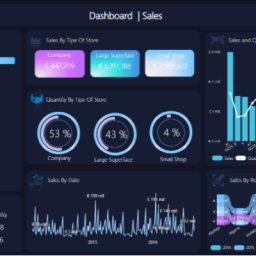
Problem Statement:
This project aims to leverage a substantial SQL Server dataset to create detailed Power BI reports. Challenges in volume and complexity require streamlined data processing. We aim to deliver efficient transformation, optimizing data usage and enhancing decision-making for our client.
Solution Overview:
We did the data processing and analysis workflow using various Azure services to create Power BI reports. Here’s a step-by-step explanation of the solution:
We did the data processing and analysis workflow using various Azure services to create Power BI reports. Here’s a step-by-step explanation of the solution:
- Ingest Data:
SQL Server to Azure Data Factory: Data from SQL Server is ingested into Azure Data Factory. Azure Data Factory is a cloud-based data integration service that allows you to create data-driven workflows for orchestrating and automating data movement and data transformation. - Store Data:
Azure Data Lake Storage: The ingested data is then stored in Azure Data Lake Storage. This is a scalable and secure data lake for high-performance analytics workloads. - Prepare and Train Data:
Databricks: The stored data is processed and transformed using Databricks. It allows for advanced data preparation, training machine learning models, and performing various transformations using languages like Python, Scala, Spark SQL, and more. - Model and Serve Data:
Azure Synapse Analytics: The transformed data is then loaded into Azure Synapse Analytics (formerly SQL Data Warehouse). This service provides big data and data warehousing solutions, enabling data integration, big data analytics, and enterprise data warehousing.
Azure Analysis Services: The data model is further refined and served using Azure Analysis Services, which provides enterprise-grade data modelling capabilities. - Power BI:
The processed and modelled data is finally visualized and reported in Power BI, allowing users to create interactive and insightful dashboards for decision-making.
Tech Stack Leveraged:
Azure Data Factory, Azure Data Lake Storage, Databricks, Azure Synapse Analytics, Azure Analysis Services, Power BI
Benefits Delivered:
• The solution leverages Azure Data Factory and Databricks for efficient data ingestion, processing, and transformation, significantly reducing the complexity and time required to handle large volumes of data from SQL Server.
• By using Azure Data Lake Storage and Azure Synapse Analytics, the solution ensures that the system can scale to accommodate growing data volumes and complex queries without compromising performance.
• Databricks and Azure Analysis Services enable advanced data preparation, transformation, and modeling, ensuring that the data is ready for in-depth analysis and actionable insights through Power BI.
• The integration with Power BI allows the client to create interactive and visually rich dashboards, empowering users to make data-driven decisions with ease and confidence.
• By utilizing Azure’s cloud-based services, the solution minimizes the need for on-premises infrastructure, reducing operational costs and allowing for flexible resource allocation based on demand.





